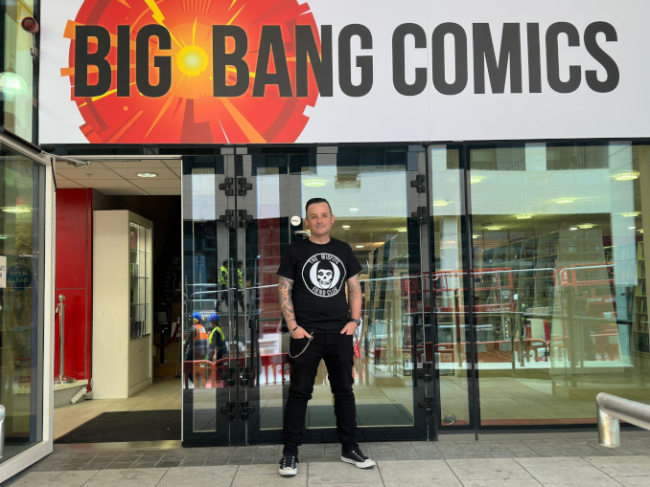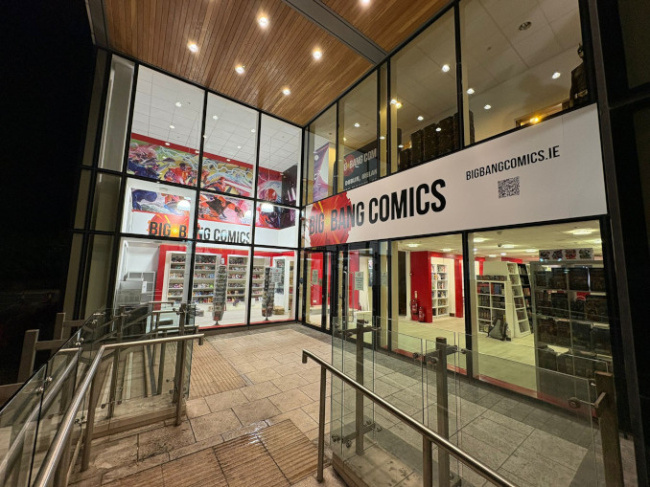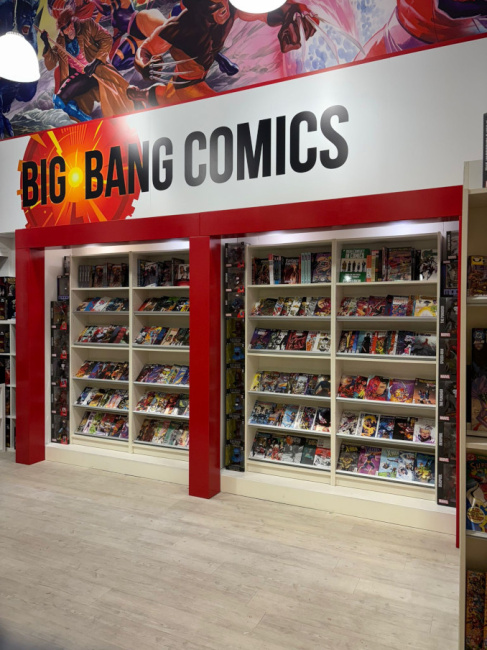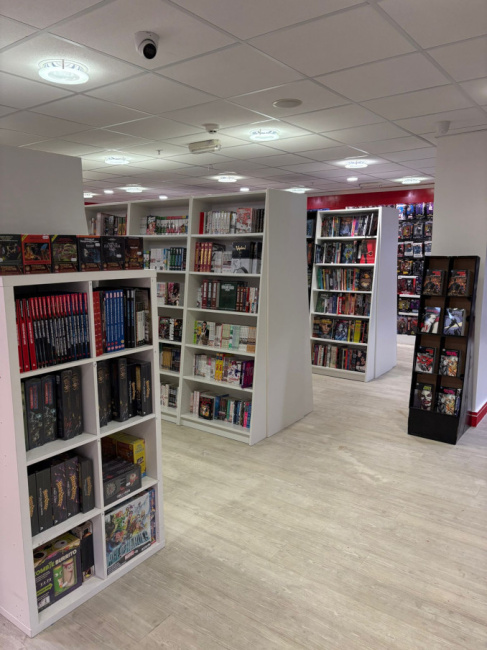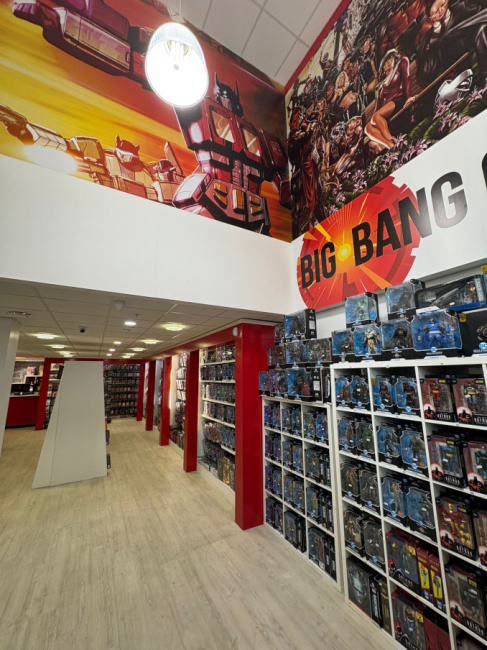Hits and Misses will feature comic retailers sharing what’s working in their shop as well as the roadblocks they’ve been running into.
It’s been a banner year for John Hendrick and his Dublin-based comic shop Big Bang Comics.
It just moved to a new location on August 2, a space that’s big enough at 8,200 square feet that its first location could fit in its new comic section alone. It isn’t just the size of the store that is expanding, though. Its daily sales are up 42% since the move, with an influx of first-time customers fueling its rise.
This new shop is built from everything Hendrick has gleaned from a life spent in comics retail. He’s been in the business for 31 years. His first job was in a comic shop at 13, and he opened his original store, called Third Place, at 20. After it closed, he tried a bevy of other jobs but nothing stuck, at least not in the way working as a comics retailer did. So, ten years after first owning a comic shop, he opened Big Bang Comics in 2011. And this time it stuck.
It’s been a year of change between the move and the departure of Hendrick’s long-time co-owner Bruno Batista earlier this year. Amidst all that, the shop is thriving as adjustments have been made to how its business is done. And with all that movement and growth, there have been plenty of hits and misses along the way, each of which he continues to learn from.
Hit: Diversifying Your Product Lines
Space limitations restricted what the shop could carry early on: it focused on comics and graphic novels. Since then, Big Bang has added manga, books, action figures, statues, blind boxes, CCGs, RPGs, and more to the mix, which has allowed the shop to insulate itself from the ups and downs of the different markets. New comics, for example, are just one part of what helps Big Bang succeed.
“Wednesday Warriors aren’t that important to us,” Hendrick said. “We don’t rely on new comic book day to pay our bills each week.”
The store’s mix of products and its location near a popular shopping center ensure a steady flow of new customers on top of its regulars. That’s by design.
“Seventy-five percent of the people we’ve served since we moved have never been in with us before; they’re new customers,” Hendrick said. “We focus on being able to cater to customers who’ve never been in a comic store before.”
“Diversification is important because if you look at our breakdown of sales, traditional comic market stuff is about 50 percent,” Hendrick added. “The rest is all what I would term mainstream-type stuff like action figures or statues.”
Diversity of product brings Big Bang two essential benefits. One is that it expands the shop’s potential customer pool.
“We are serving grandparents buying toys for their grandchildren, and we’re serving loads of kids,” Hendrick told us. “Today, a big group of them came in and they bought Marvel omnibuses because to them this was the best bang for their buck, and [that] was their first comic.”
The second benefit is that it allows the shop to create cross-product line successes. Hendrick pointed to Skybound’s Energon Universe as proof of that concept.
“That was the first time we’ve been able to turn action figure customers into comic readers, and vice versa,” he said. “Comic readers who have never picked up the toys are now. It’s worked so well.”
“We turn those people into all-encompassing customers,” he added. “That’s the whole point.”
Miss: Not Pacing Yourself
It might not surprise you to learn that one challenge for a shop that tries to be everything for everyone is a tendency to overreach.
“Doing too much,” Hendrick said about one of his main challenges. “That can be a real problem.”
A good example of that was Dublin International Comics Expo (D.I.C.E.), a comic convention Big Bang ran between 2012 and 2014. D.I.C.E. was something its staff put on while operating the shop as per usual. Running either a comic shop or a comic convention is a lot of work. Doing both was too much.
“D.I.C.E. is a huge regret of mine,” Hendrick said. “It burned us out.”
Burnout has proven to be a regular problem for Hendrick. Our conversation took place during the 11pm hour after the shop had closed, and he was putting new comics on the shelves as we talked. After that, he still had several tasks to do before he could go home. That isn’t unusual, nor is it new.
“I have been working like this solidly for two months now,” he admitted. “I know I can’t keep it up, but I know that I had to do it for this whole period. It’s just part of the game.”
That’s why Hendrick’s advice for his peers is simple.
“Pace yourself,” he said.
He’s hopeful that once the new shop is fully operational, he’ll have more regular hours. But even then, he still has bigger plans in mind like finishing the new location’s second floor, a refresh of Big Bang’s website, and opening another location in two years.
“It’s not my nature to pace myself,” he emphasized.
He’s working on it, though.
Hit: Ordering for Growth
One major change for the shop of late has been how it orders comics. Its previous goal was to sell out by the Saturday of the same week. Now, Big Bang has changed how it orders, which is part of a new objective for the shop.
“We order for walk-ins, not sell-outs,” Hendrick told me.
And it’s working.
“Comic sales are the best we’ve ever had,” he said.
The hope is to become the place where customers can always find what they’re looking for, and to do that, Hendrick is betting bigger on titles he views as probable successes.
“I don’t do it with everything, but there’s stuff I’m okay with ordering extras of, like Artgerm covers or Absolute or Ultimate titles,” Hendrick said. “If I’m selling 47 copies of Assorted Crisis Events, it’s no big deal to have four or five extras just in case. And we do see growth with those.”
When other shops are out of that week’s hot book, customers turn to Big Bang, which has it in stock. Hendrick is using that as a chance to make them something more.
“We try and turn them into repeat customers by setting them up with accounts, explaining our rewards program, and explaining how to order on our website,” Hendrick shared. “So then if they buy issue one of what’s on the shelf, they’ll want to get issues two, three and four.”
That doesn’t mean Hendrick is ordering at levels the shop cannot handle. Besides spinner racks filled with recent debuts, the shop doesn’t reserve customer-facing space for comics beyond the first week. But it has worked out a system that allows it to take advantage of that extra inventory. Right next to the register is a room filled with roughly 10,000 comics, and Hendrick estimates that Big Bang makes online and in-store sales multiple times an hour from that stock.
“It’s not adding much to our risk,” Hendrick said. “But it’s adding a lot to our gains.”
Whether it’s a new number one or later issues of top sellers, they want to have stock on hand so they can turn new customers into old ones. It’s a huge change, but it’s working.
“We aim for growth every time,” Hendrick said. “And that has helped us get loads of new customers.”
Hit: The Power of Email
Big Bang’s external promotional channels have proven to be powerful tools, and its biggest success has been its email marketing efforts. The shop has dedicated lists delineated by product line, and it’s found that these email blasts, each of which offer customers direct links to where they can preorder or purchase the product, have resulted in real gains.
“We generate serious sales from that,” Hendrick said.
That’s particularly true on the action figure front. That product line has surged alongside corresponding email marketing efforts. These emails are sent through Mailchimp with information about new and upcoming products alongside direct links to where these figures can be purchased. But it extends beyond email, as they want to make sure their messaging reaches potential customers outside existing ones.
“A lot of customers don’t subscribe to those emails, but they will see them through Facebook, because (that) is where all the action figure customers go,” Hendrick said. “They’re on the action figure forums.”
These larger email efforts have resulted in significant growth in revenue and customer acquisition, both in action figures and comics. Big Bang does everything it can to bolster preorders for new comics via email, something its point-of-sale system ComicHub makes easy. The shop can target customers who already pull certain titles in their ComicHub account and then send sales emails about related comics directly through the system.
“If you have a pull list here and there’s a new Spider-Man title coming out and we think you’ll like it, you’re going to know about it because we’re going to email you about it,” Hendrick said.
Those emails are part of the reason Skybound’s Transformers is one of its biggest sellers.
“I will send emails to Transformers action figure customers that say, ‘Hey, there’s this new Transformer figure, and he was also in the second volume of Daniel Warren Johnson’s Transformers with a link to the book,'” Hendrick said. “And we get sales out of that too.”
Miss: Thinking You’re the Best
One trap Hendrick has fallen into over the years has been believing he knows everything, which he admits is a problem.
“The miss is learning that you can’t just think you are the best,” Hendrick said.
That can lead to weaknesses in your product mix and unsatisfied customers. Hendrick shared an example of how he had faltered recently in that regard.
“One market I let go was manga. When [Batista] left, I found it hard to order manga,” Hendrick said. “You need to listen, and I didn’t.”
To better understand manga, he’s been doing what he can to listen more. He’s paying close attention to what customers are discussing, learning from his staff, and talking with his peers about what’s working. The latter has been proven particularly helpful in figuring out the right approach with manga.
“There are people that I know who are really good at manga, and I’ve been reaching out to them,” Hendrick said. “Jared Myland of OK Comics, Steve Anderson of Third Eye Comics, and Rob Pontefract at Forbidden Planet UK have helped me out.”
Open communication isn’t the easiest thing for Hendrick, especially given his perpetual time crunch. That’s why he’s trying to change his approach after the shop’s recent move.
“The store has leveled up and I feel that [I have] to level up at the same time,” Hendrick said. “And that requires learning new things and to deal with things in a different way.”
“Everything has to be planned,” Hendrick added. “I’ve become a lot better in terms of my timing. I’ve become a lot better in terms of my scheduling. I’ve become a lot better in terms of [being] more goal oriented.”
Even as he works to improve, Hendrick knows Big Bang has weaknesses. And recognizing that is important, because it means this topic isn’t just a miss.
“It’s also incentive to get better,” Hendrick said.
Hit: Think Visually
Hendrick has always wanted the shop to have an inviting, appealing look. He believes how you present yourself to the public dictates how customers will engage with you.
“You wouldn’t buy your shoes in a dingy shoe store. You’d go to Foot Locker because everything’s clean and there’s a certain standard,” Hendrick said. “Just because you sell comics doesn’t mean you should let yourself or the product down.”
Visuals are an emphasis for Hendrick. That includes imagery featured around the shop unrelated to Big Bang itself. He puts significant thought into everything in the store.
“Outside the store, you see the signage, but you also see an Alex Ross X-Men piece and a Mark Brooks X-Men piece,” Hendrick said. “The reason I picked the X-Men and not the Avengers is the X-Men are the focus for the next 10 years in the Marvel Cinematic Universe.”
“And you see the Transformers because Transformers is a huge part of what we do, both in comic books and they are our top selling action figure line,” he added. “And we’re very much a Transformers store.”
If product visuals are important, then the shop’s own branding is doubly so. Hendrick is building a brand, one that says Big Bang Comics. Literally.
“Big Bang Comics is written everywhere in the store and in every photo,” Hendrick said.
That’s part of its larger evolution. In its first two iterations, it looked as good as it could in a limited space. But its new location was designed to be its ideal form, and it’s built on the brand the shop has been cultivating over the years.
It all started with the logo: created by Pye Parr, who previously was a designer for 2000 AD, it’s been the foundation for Big Bang’s entire aesthetic.
“The color scheme for the store is designed around the logo and the bags that Pye created,” Hendrick said.
“It’s all branding, and that’s super important,” Hendrick added. “That will become more important as time goes on.”
That’s because Big Bang staff will have uniforms starting in October, which is a major change. But it’s part of the retailer’s larger vision for the shop. He wants Big Bang’s visual aesthetic to reinforce the work, just like his favorite retail stores do.
“Everyone asks if we’re a chain,” Hendrick said. “And that’s how I want the store to look.”
Click Gallery below for full-size images of Big Bang’s new location!
Read more at this site

